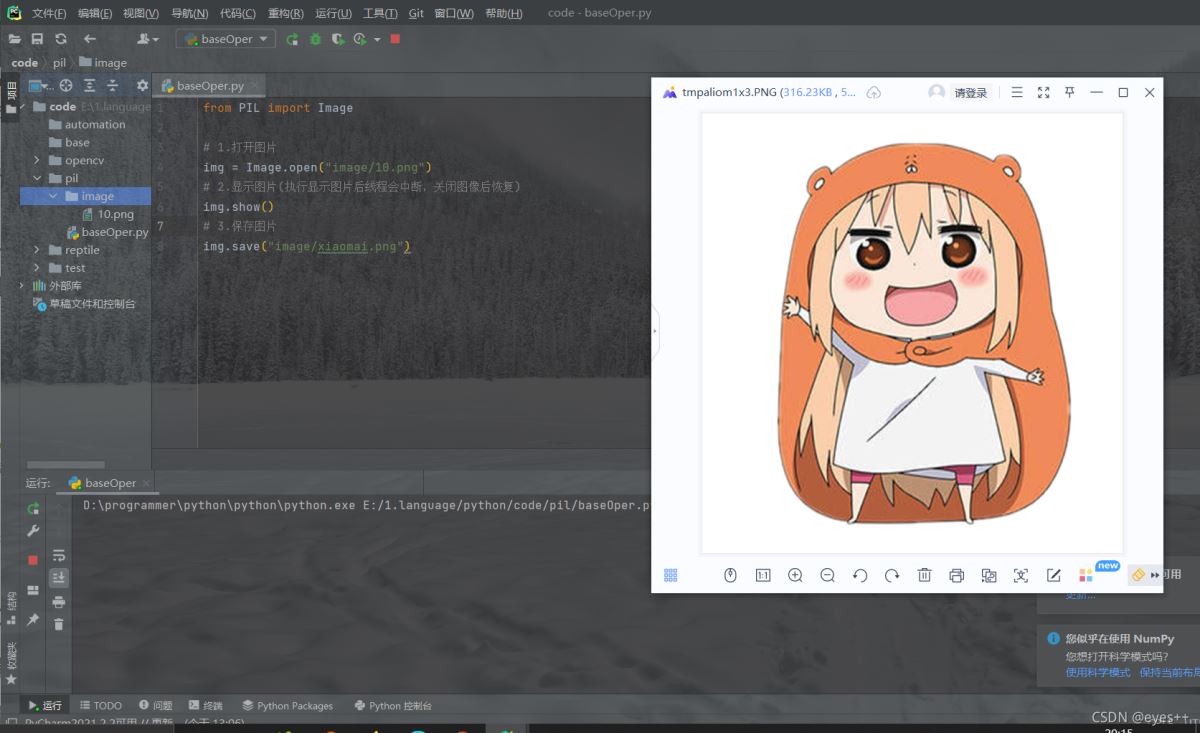本文实例讲述了Python内置模块logging用法。分享给大家供大家参考,具体如下:
1、将日志直接输出到屏幕
import logging
logging.debug('This is debug message')
logging.info('This is info message')
logging.warning('This is warning message')
# 默认情况下,logging将日志打印到屏幕,日志级别为WARNING;
#output====================================
# WARNING:root:This is warning message
2.通过logging.basicConfig函数对日志的输出格式及方式做相关配置
import logging
logging.basicConfig(level=logging.DEBUG,
format='%(asctime)s %(filename)s[line:%(lineno)d] %(levelname)s %(message)s',
datefmt='%a, %d %b %Y %H:%M:%S',
filename='myapp.log',
filemode='w')
logging.debug('This is debug message')
logging.info('This is info message')
logging.warning('This is warning message')
#./myapp.log文件中内容为:
#Sun, 24 May 2009 21:48:54 demo2.py[line:11] DEBUG This is debug message
#Sun, 24 May 2009 21:48:54 demo2.py[line:12] INFO This is info message
#Sun, 24 May 2009 21:48:54 demo2.py[line:13] WARNING This is warning message
logging.basicConfig参数:
#logging.basicConfig函数各参数:
filename: 指定日志文件名
filemode: 和file函数意义相同,指定日志文件的打开模式,'w'或'a'
format: 指定输出的格式和内容,format可以输出很多有用信息,如上例所示:
%(levelno)s: 打印日志级别的数值
%(levelname)s: 打印日志级别名称
%(pathname)s: 打印当前执行程序的路径,其实就是sys.argv[0]
%(filename)s: 打印当前执行程序名
%(funcName)s: 打印日志的当前函数
%(lineno)d: 打印日志的当前行号
%(asctime)s: 打印日志的时间
%(thread)d: 打印线程ID
%(threadName)s: 打印线程名称
%(process)d: 打印进程ID
%(message)s: 打印日志信息
datefmt: 指定时间格式,同time.strftime()
level: 设置日志级别,默认为logging.WARNING
stream: 指定将日志的输出流,可以指定输出到sys.stderr,sys.stdout或者文件,默认输出到sys.stderr,当stream和filename同时指定时,stream被忽略
3、将日志同时输出到多个Handler
先定义一个住handler,并使用addHander()添加到主handler,实现日志输出到多个handler.
a、同时输出到文件和屏幕
import logging
#设置一个basicConfig只能输出到一个Handler
logging.basicConfig(level=logging.DEBUG,
format='%(asctime)s %(filename)s[line:%(lineno)d] %(levelname)s %(message)s',
datefmt='%a, %d %b %Y %H:%M:%S',
filename='myapp.log',
filemode='w')
#定义一个StreamHandler,将INFO级别或更高的日志信息打印到标准错误,并将其添加到当前的日志处理对象#
console = logging.StreamHandler()
console.setLevel(logging.INFO)
formatter = logging.Formatter('%(name)-12s: %(levelname)-8s %(message)s')
console.setFormatter(formatter)
logging.getLogger('').addHandler(console)
#输出到文件的log级别为debug,输出到stream的log级别为info
logging.debug('This is debug message')
logging.info('This is info message')
logging.warning('This is warning message')
b、添加一个handler:输出到文件,并根据文件大小滚动存储
在a的基础上添加一个handler
from logging.handlers import RotatingFileHandler
#定义一个RotatingFileHandler,最多备份5个日志文件,每个日志文件最大10M
Rthandler = RotatingFileHandler('myapp.log', maxBytes=10*1024*1024,backupCount=5)
Rthandler.setLevel(logging.INFO)
formatter = logging.Formatter('%(name)-12s: %(levelname)-8s %(message)s')
Rthandler.setFormatter(formatter)
logging.getLogger('').addHandler(Rthandler)
logging几种Handler类型:
logging.StreamHandler(默认): 日志输出到流,可以是sys.stderr、sys.stdout或者文件
logging.FileHandler: 日志输出到文件
logging.handlers.RotatingFileHandler 日志输出到文件,基于文件大小滚动存储日志
logging.handlers.TimedRotatingFileHandler 日志输出到文件,基于时间周期滚动存储日志
logging.handlers.SocketHandler: 远程输出日志到TCP/IP sockets
logging.handlers.DatagramHandler: 远程输出日志到UDP sockets
logging.handlers.SMTPHandler: 远程输出日志到邮件地址
logging.handlers.SysLogHandler: 日志输出到syslog
logging.handlers.NTEventLogHandler: 远程输出日志到Windows NT/2000/XP的事件日志
logging.handlers.MemoryHandler: 日志输出到内存中的制定buffer
logging.handlers.HTTPHandler: 通过"GET"或"POST"远程输出到HTTP服务器
4、通过配置文件配置logger
a、定义配置文件logger.conf
#logger.conf
###############################################
[loggers]
keys=root,example01,example02
[logger_root]
level=DEBUG
handlers=hand01,hand02
[logger_example01]
handlers=hand01,hand02
qualname=example01
propagate=0
[logger_example02]
handlers=hand01,hand03
qualname=example02
propagate=0
###############################################
[handlers]
keys=hand01,hand02,hand03
[handler_hand01]
class=StreamHandler
level=INFO
formatter=form02
args=(sys.stderr,)
[handler_hand02]
class=FileHandler
level=DEBUG
formatter=form01
args=('myapp.log', 'a')
[handler_hand03]
class=handlers.RotatingFileHandler
level=INFO
formatter=form02
args=('myapp.log', 'a', 10*1024*1024, 5)
###############################################
[formatters]
keys=form01,form02
[formatter_form01]
format=%(asctime)s %(filename)s[line:%(lineno)d] %(levelname)s %(message)s
datefmt=%a, %d %b %Y %H:%M:%S
[formatter_form02]
format=%(name)-12s: %(levelname)-8s %(message)s
datefmt=
b、logging.config获取配置
import logging
import logging.config
logging.config.fileConfig("logger.conf")
logger = logging.getLogger("example01")
logger.debug('This is debug message')
logger.info('This is info message')
logger.warning('This is warning message')
import logging
import logging.config
logging.config.fileConfig("logger.conf")
logger = logging.getLogger("example02")
logger.debug('This is debug message')
logger.info('This is info message')
logger.warning('This is warning message')
希望本文所述对大家Python程序设计有所帮助。
到此这篇关于Python内置模块logging用法实例分析就介绍到这了。人生不售来回票,一旦动身,绝不能复返。更多相关Python内置模块logging用法实例分析内容请查看相关栏目,小编编辑不易,再次感谢大家的支持!





